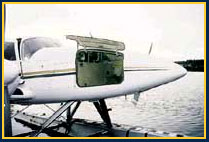Flying the Aztec Nomad Seaplane
BRACEBRIDGE: When I arrived at Spence Lake, about ½ NM from Muskoka Airport Runway, I could immediately see the Aztec Nomad was no small plane! It was a hot hot day in July with temps over 30C.
The Edo model 4930 floats had been installed on the Aztec under the applicable STC’s, making it a very impressive looking seaplane with extremely masculine lines.
After an initial orientation and a preflight on the plane, Dave Gronfors and I climbed aboard. The top of the Edo floats are flat, which makes it an easy step up to the wing of the Aztec
The big Cargo and Boarding Ladder on the right side, made entry very easy. Another of the noticeable features of Air Muskoka’s installation kit is the left door, which makes it much simpler to dock the Aztec Nomad.
With both engines started, we pulled away from the wharf easily. It had been a long time since I had flown Twin Engine Sea and Dave Gronfors, President of Air Muskoka (the conversion facility company) assisted me with first time orientation and operation of the standard levers. Out on Lake Spence with Flaps about ½, Props in high pitch, throttles up to the firewall, and slight back-pressure brought the floats right up on the step in about four or five seconds, and then the Aztec Nomad accelerated rapidly. In about nine seconds more, we were airborne. In a normal climb of 26 inches and 2400 rpm, this gave us over 1000 fpm R.O.C.
We flew around the small lake and then headed towards the famed Muskoka Lakes area for airwork and landing practice. After about ½ hour of upper airwork and single engine drills complete, we began some landings on beautiful Lake Muskoka.
With a stabilized pattern speed of 100 MPH and an approach speed of 80-90 MPH on long final, the Aztec Nomad trimmed up well for hands-off control. Entering the flare zone (across the fence for you landplane folks), I reduced power to about 10-12″ MP and 75-80 MPH reducing speed more as we flared for touch down and there it was, a perfect landing. Simple.
Taxiing back to takeoff position, Dave Gronfors said, “Watch this, I want to show you something,” and killed the port engine. Even with the dead engine on one side, we were able to turn into the starboard engine with full control, and we made several circles in both directions, demonstrating the complete control afforded with these retractable float rudders. You can fly without water rudders and dock the plane too if desired!
I took the controls once again, and after lining up for takeoff without the use of the rudders, I checked water rudders were still retracted onto their simple fuel quadrant pylon location. Fuel Boosters on, Flaps ½, Props in high pitch, Throttles full power with slight but positive back pressure on the control wheel brought the Nomad up onto the step. Then, easing the wheel a bit forward to establish optimum planing angle for a few seconds, I again brought the wheel back with a little more pressure, and the Aztec flew right off the water.
You might call this Aztec the King of the Twin Floatplanes. It has a very regal, solid feeling with power to spare.
I pulled the 250-horse engines back to climb power, 75 per cent. Total time for getting off the water was about 14 or 15 seconds. With nearly full standard fuel (144 USG) and two male adults, and a survival kit of about 50 lbs. In the large rear baggage hold, we were about 450 pounds under the gross weight of 5200 lbs.





One thing is sure; I never assumed the Piper Aztec Nomad Twin Engine Floatplane would be so easy to fly, operate, dock and to service. And No Vmc, just made my summer one to remember. Stay tuned for more Pilot Reports in Upcoming Issues of NOMAD PILOT REPORTS.
Author: Peter R.Hanna, Commercial Pilot, 10,000 Hour Multi Land & Sea Pilot from British Columbia.